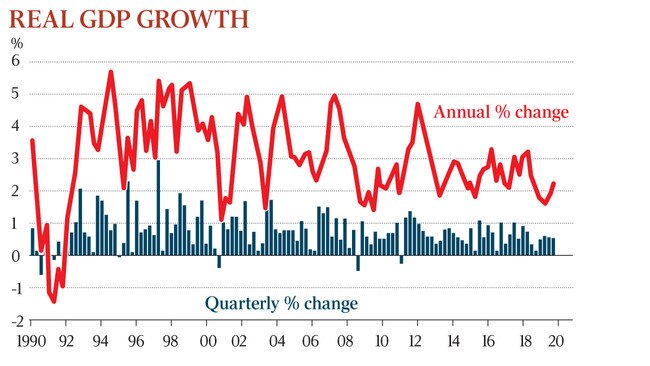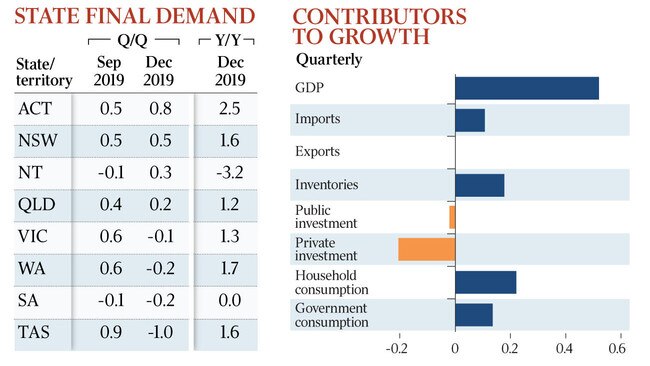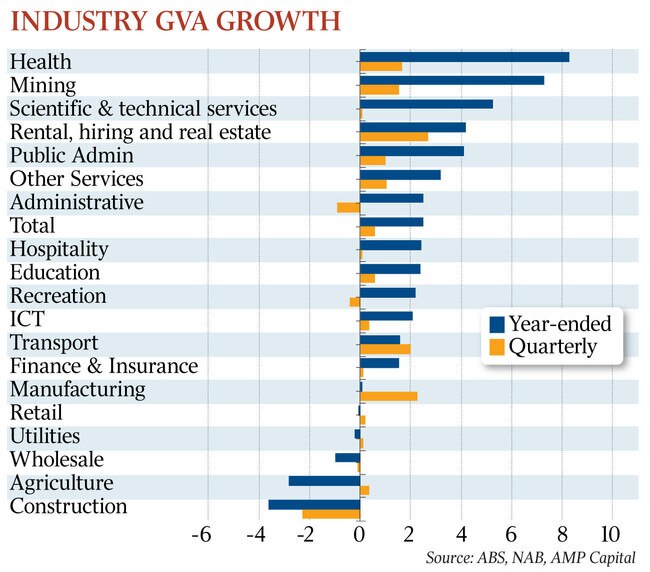Coronavirus: economy ‘fragile’ but on the rise before twin disasters struck
The economy was on the up in the final months of 2019, with annual GDP growth accelerating to 2.2 per cent from 1.8 per cent over the year to September.

The economy was on the up in the final months of 2019, with annual GDP growth accelerating to 2.2 per cent from 1.8 per cent over the year to September.
A modest but welcome lift in consumer spending helped push GDP up 0.5 per cent over the December quarter, according to national accounts figures released on Wednesday. Economists had expected a 0.3 to 0.4 per cent increase. The Australian Bureau of Statistics also revised growth higher for the previous quarter, to 0.6 per cent.
The better-than-expected figures will come as cold comfort as the ongoing impact of the bushfires and the growing threat posed by the coronavirus are expected to weigh heavily on the economy in the first and perhaps second quarters of 2020. Consumer spending lifted 0.4 per cent in the three months, after a 0.1 per cent gain in the prior quarter.
Australians spent more on household goods, furnishings, and clothes and shoes, the data showed. Economists pointed to the success of pre-Christmas sales as a possible reason for the extra spending, but Josh Frydenberg was quick to say it was evidence that households had started to spend their increased tax rebates.
A climbing housing market may have also contributed to the additional spending, alongside the three rate cuts in the second half of last year.
Annual consumer spending growth remained stuck at 1.2 per cent, its slowest pace since the GFC and well down from the 2 per cent growth in 2018. After adjusting for population growth, spending declined.
The accounts confirmed an overall picture of weak domestic demand, propped up by strong growth in government spending and the booming export sector.

Home building contracted 3.4 per cent through the quarter, and by 9.7 per cent in 2019, against an increase of 3.3 per cent in the previous year. New business investment fell by 1.2 per cent in 2019, after dropping by 0.8 per cent in 2018. Overall, private demand increased by only 0.1 per cent in 2019 compared with 1.3 per cent in 2018 — displaying the weak underbelly of the economy.
Westpac chief economist Bill Evans said the data showed that “momentum in the economy going into 2020 was quite fragile”.

“Associated with this, the mood of consumers and businesses is downbeat,” he said.
In contrast, net exports and government spending provided support for the economy. The trade sector contributed half of the year’s economic growth, although a 10-15 per cent fall in iron ore and coal prices in the final quarter weighed on nominal growth.
Public spending lifted by 5.1 per cent over the year.
State demand was weak in the fourth quarter, up just 0.1 per cent overall. NSW and Queensland were the only states to experience meaningful growth, up by 0.5 per cent and 0.2 per cent, although the ACT lifted 0.8 per cent.
Final demand in Victoria declined 0.1 per cent, and Western Australia and South Australia shrank 0.2 per cent over the three months. The Northern Territory recorded growth of 0.3 per cent, while Tasmania suffered a 1 per cent drop.





To join the conversation, please log in. Don't have an account? Register
Join the conversation, you are commenting as Logout